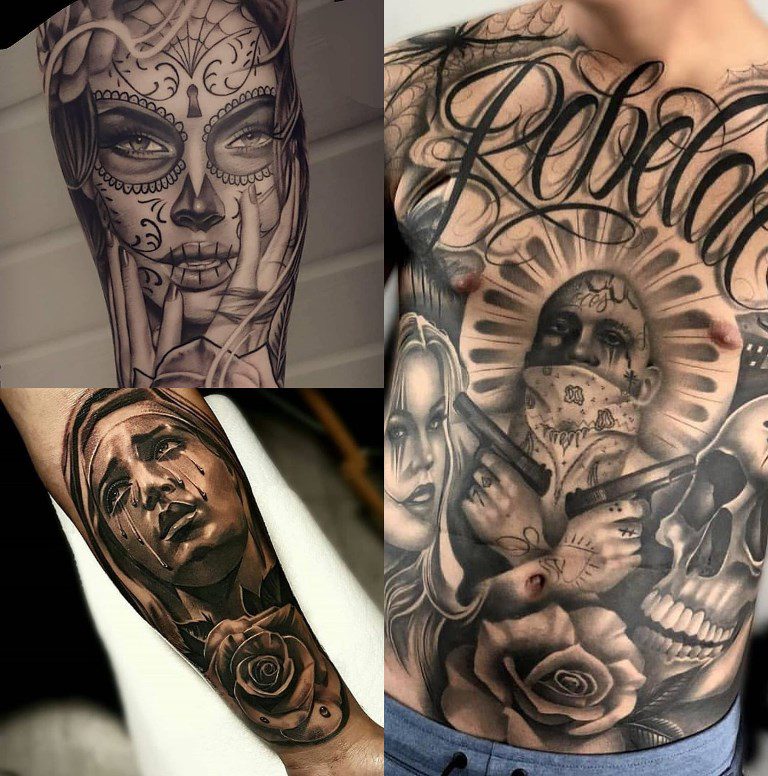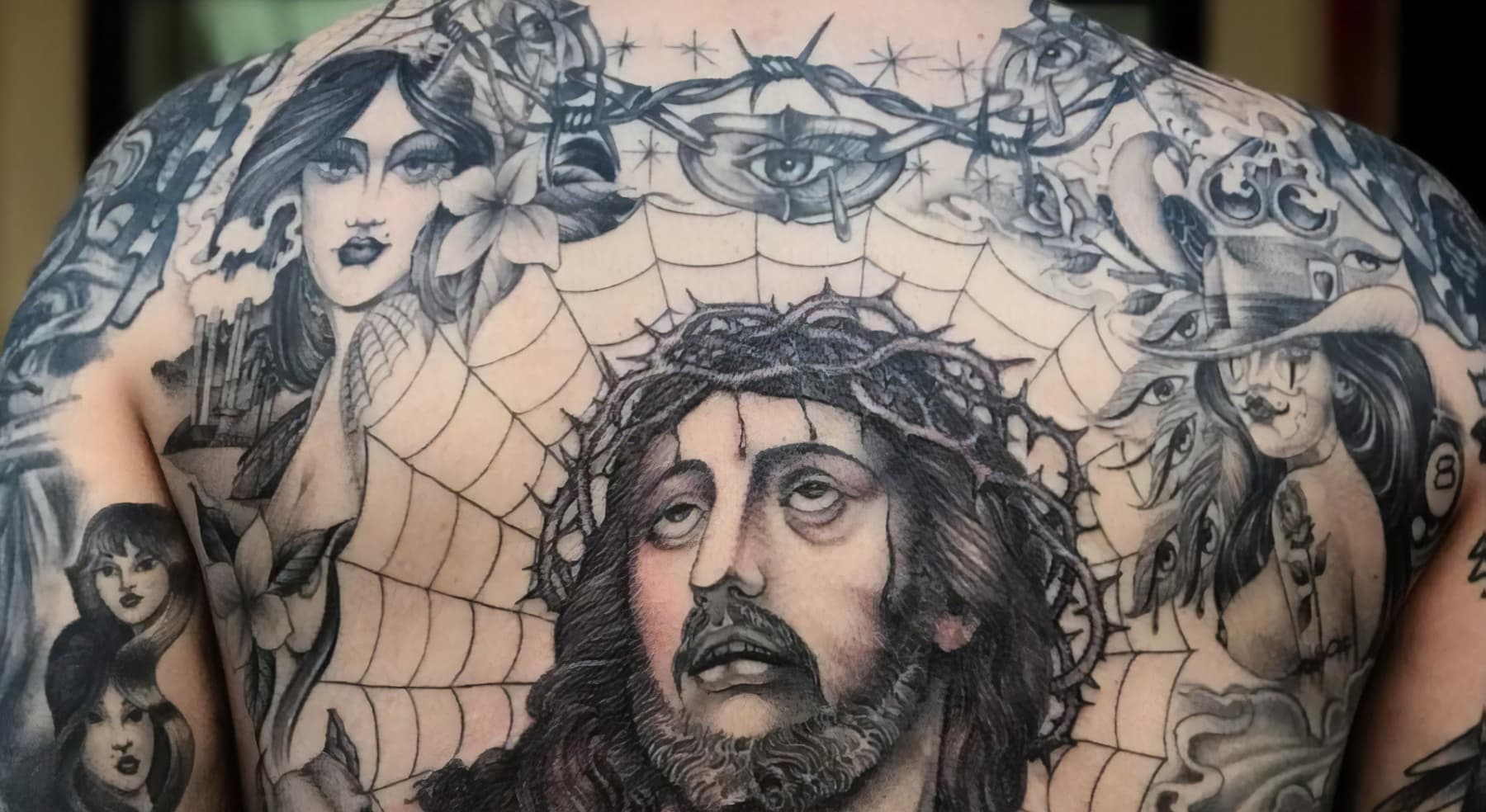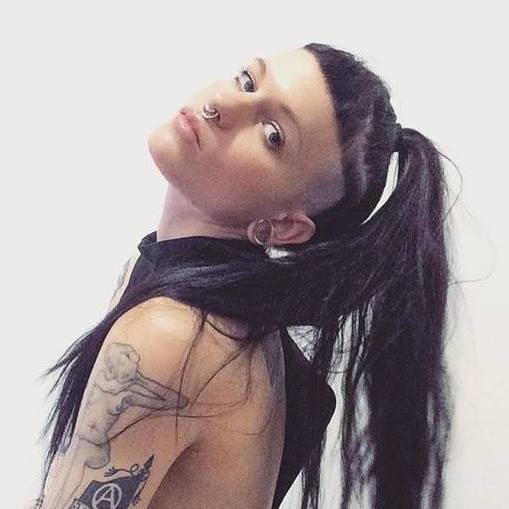
Chicano Tattoos: Roots, Cultural References, and Artists
Contents:
- Мanagement
- Styles
- Chicano

This guide to Chicano tattoos looks at the historical roots, cultural references, and artists who have also mastered the craft.
- Chicano artists have a powerful philosophical and political heritage and this tattoo style reflects that.
- Prison culture, which has had a profound effect on Chicano tattoo art since the 40s, is mostly associated with arrests, which were often a by-product of xenophobic social forces against migrants.
- Prison inmates built a homemade tattoo machine and, using only the black or blue ink they had, drew what they knew best.
- Scenes from gangster life, beautiful women, nimble lowriders, inscriptions, Catholic iconography - all this became the basis of Chicano tattoos.
- Chuco Moreno, Freddy Negrete, Chui Quintanar, Tamara Santibanez, Mister Cartoon, El Weiner, Panchos Plakas, Javier DeLuna, Jason Ochoa and José Araujo Martinez are all highly respected artists for their Chicano tattoos.
- The Historical Roots of the Chicano Tattoo
- Cultural References in Chicano Tattoos
- Chicano tattoo iconography
- Tattoo artists at Chicano Tattooing
Payas, lush roses, Virgin Marys and intricate rosaries are the first things that come to mind when you think of Chicano tattoos. And while it's true that these are some of the main elements of the style, this particular tattoo fraction has depth like some others. From Los Angeles history to ancient Aztec artifacts and even Roman Catholic iconography, this guide to Chicano tattooing takes a look at not only historical roots, stylistic and cultural references, but also the artists who have mastered the craft.
The Historical Roots of the Chicano Tattoo
Smooth tones of gray underline the illustrative approach to much of the Chicano tattoo movement. Given his roots in pencil and ballpoint drawing, it's no surprise that stylistically, the artwork combines these techniques with an incredibly rich cultural background. Although many people are familiar with the work of Frida Kahlo and Diego Rivera, other artists such as Jesus Helguera, Maria Izquierdo and David Alfaro Siqueiros have also been at the forefront of Mexican artistic creation. Their work, along with other South American artists, mainly focused on depicting political strife, family representations, and illustrations of everyday life. While these works may seem far removed from contemporary Chicano tattoos, the figurative studies and illustrative approaches that combine realism with surrealism partly explain why much of contemporary Chicano art has the distinct look for which it is known.
As with many art movements, aesthetics and techniques can be borrowed, but what's special about this tattoo style is the culture and past behind it; Chicano artists have a powerful philosophical and political heritage. With a history that includes radicals such as Francisco Madero and Emiliano Zapata, it's no wonder that from the Mexican Revolution to the Pachuco culture of the early 1940s and beyond, socio-political writings and actions have had a huge impact on modern Chicano tattooing. Even before the 40s, when Mexican American youth and members of other minority cultures used Zoot Suits to express their dissatisfaction with traditional American politics and politics, artistic stylistic expression was often used as an effective tool. Frescoes were also often used in dialectical conversation about civil law and government.
Cultural References in Chicano Tattoos
The reason so much of the Chicano tattoo style feels so personal is because it is. Migrants who made their way from Mexico to parts of Texas and California were forced to be marginalized by rampant racism, classism and discrimination. While this caused a bitter struggle for the migrant population, it also meant that their culture was protected and kept intact for generations. As migration peaked from the 1920s to the 1940s, many Chicano youths fought against the status quo. In 1943, this finally culminated in the Zoot suit riots sparked by the death of a young Hispanic man in Los Angeles. This may seem insignificant in the background of the Chicano tattoo style, but this was not the first and not the last case of the suppression of the expression of culture. It's no secret that much of this conflict resulted in arrests, which were often a by-product of society's xenophobic pressure on migrants. This political turn undoubtedly had an immediate impact on the Chicano aesthetic.
After the demise of the pachuco subculture, life in Los Angeles changed. Kids traded in their Zoot suits for crisp khakis and bandanas and redefined what being Chicano meant to their generation. Stylistic approaches emerged that were directly influenced by life behind bars. Using the few materials they had in the prison or barrio dotting the Los Angeles landscape, the artists drew inspiration directly from their own life experiences. Scenes of gang life, beautiful women, sleek cars with filigree lettering, and Catholic crosses quickly evolved from hand-drawn illustrations like ballpoint pen-embellished handkerchiefs and linens called Paños to iconic Chicano tattoos. The prisoners used sheer ingenuity to assemble a homemade tattoo machine and, using only the black or blue ink available to them, depict what they knew best. Like most people who are passionate about the art of tattooing, this craft was used as a way to own the body, to express oneself, and to show closeness to things that were closest.
In fact, the intricacies of Chicano tattoo iconography are so entangled in the history of ethnic unrest and progressive independence that it can be hard for outsiders to understand. However, it is such an integral part of West Coast culture that many of the ancillary aspects of the aesthetic have been taken up by mainstream society, making it more accessible and widely appreciated. Films like Mi Vida Loca and the underground magazine Teen Angels embody the spirit of a style that may have been drawn from a violent past but was the pure product of love and passion. The opening of stores like Good Time Charlie's Tattooland and artists like Freddy Negrete, founders of the Los Angeles Chicano community from the 70s to the present, have brought aesthetics to the forefront of the tattoo community. Cholas, Payasas, Lowriders, inscriptions, tears representing the lost: all this and more has been a way of life depicted in various forms of art, including Chicano tattoos. These artworks resonate so deeply with the people in the community because they are directly inspired by their own history, their own history. A testament to the power of these images is that the reach and recognition of this genre continues to grow.
Chicano tattoo iconography
As is the case with most tattoo iconography, many Chicano tattoo design concepts are significant. Many of these core designs are intertwined with facets of the Chicano culture. Tattoos featuring lowriders, another mainstay of the late 1940s and 50s that opposed the English aesthetic, pit bulls, dice and decks of cards, speak to the Los Angeles lifestyle. Tattoos depicting cholos with their "drive or die" babes are another design that often mixed inmates' appreciation for car culture with longing for their sweetheart on the outside. Perhaps the Payasas, which means "clown" in Spanish, are among the most famous images in this style. Inspired by the dramatic and comedic masks they often resemble, these portraits allude to the balance of hardship and happiness in life. The saying "Smile now, cry later" also often accompanies these works. Sacred Hearts, Virgin Marys, Sugar Skulls, Praying Hands and the like are all images borrowed from the archives of Roman Catholic symbols and saints; this religion is widely known in North America, and about 85% of the Mexican population practice it alone.
Tattoo artists at Chicano Tattooing
Many tattoo artists working in the Chicano tattoo style are part of the Chicano community themselves. There is an important aspect of preserving and respecting heritage that makes appropriation difficult; it can be difficult to replicate images if there is no genuine understanding and personal connection. However, designs are so pervasive in the history of tattooing that many artists have mastered the aesthetic and are helping to preserve and spread this integral part of tattoo culture. Chuco Moreno, Freddy Negrete, Chui Quintanar and Tamara Santibanez are at the forefront of modern Chicano tattooing. As in any artistic direction, each artist can work within the framework of stylistic iconography, giving it a more individual touch. From black and gray realism to graphite illustrations and even the American traditional Chicano style, the Chicano tattoo style combines many aspects of tattoo culture in a beautiful array of techniques and visuals. Other artists with a distinct personal style include Freddy Negret, Mister Cartoon, El Whyner, Panchos Placas, Javier DeLuna, Jason Ochoa and Jose Araujo Martinez. Although many of these tattoo artists do not strictly adhere to one style or another, it is clear that each one appreciates their own culture and experience. This is clearly reflected in their highly regarded work.
It's hard to think of Chicano tattoos without all the historical, political and philosophical connotations. Much of the historical and socio-political work produced in the past is still shockingly relevant today. But that's part of what makes the style so impressive. The culture was beautifully expressed through this art form and continues to influence people all over the world.
JM
By Justin Morrow
Leave a Reply